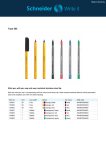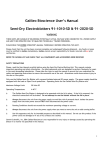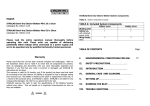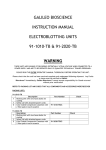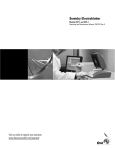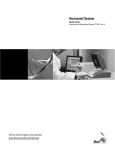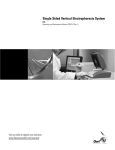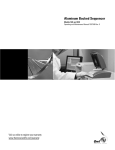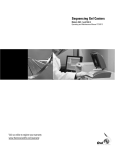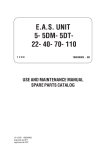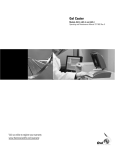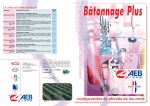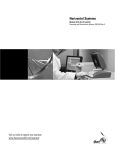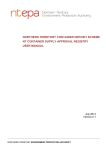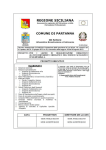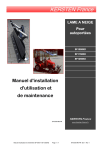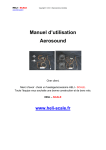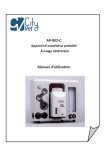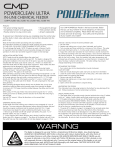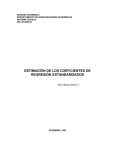Download VEP-2 and VEP-3 Tank Electroblotting System User Manual
Transcript
Tank Electroblotting System Models VEP-2 and VEP-3 Operating and Maintenance Manual 7007351 Rev. 0 Visit us online to register your warranty www.thermoscientific.com/warranty Preface VEP-3 VEP-2 MANUAL NUMBER 7007351 0 -- 4/30/12 REV ECR/ECN DATE Thermo Scientific Transfer to Marietta (was The Bandit 3/2003) ccs DESCRIPTION By Tank Electroblotting System i Preface Important Read this instruction manual. Failure to read, understand and follow the instructions in this manual may result in damage to the unit, injury to operating personnel, and poor equipment performance. s Caution All internal adjustments and maintenance must be performed by qualified service personnel. s Warning To avoid the risk of personal shock, always disconnect the gel box from the power supply. Further, the power supply must be equipped with a shut-down-on-disconnect circuit. Running conditions for this unit should not exceed the name plate readings found on the lower buffer chamber. Do not move the unit unless the power source to the unit has been disconnected. s Statement of Proper Use: Use this product only for its intended purpose as described in this manual. Do not use this product if the power leads are damaged or if any of its surfaces are cracked.This system is designed to meet IEC 1010-1 safety standards (IEC 1010-1 is an internationally accepted electrical safety standard for laboratory instruments). Material in this manual is for information purposes only. The contents and the product it describes are subject to change without notice. Thermo Fisher Scientific makes no representations or warranties with respect to this manual. In no event shall Thermo be held liable for any damages, direct or incidental, arising out of or related to the use of this manual. ©2012 Thermo Fisher Scientific. All rights reserved. ii Tank Electroblotting System Thermo Scientific Preface Important operating and/or maintenance instructions. Read the accompanying text carefully. Potential electrical hazards. Only qualified persons should perform procedures associated with this symbol. Equipment being maintained or serviced must be turned off and locked off to prevent possible injury. Hot surface(s) present which may cause burns to unprotected skin, or to materials which may be damaged by elevated temperatures. Marking of electrical and electronic equipment, which applies to electrical and electronic equipment falling under the Directive 2002/96/EC (WEEE) and the equipment that has been put on the market after 13 August 2005. This product is required to comply with the European Union’s Waste Electrical & Electronic Equipment (WEEE) Directive 2002/96/EC. It is marked with the WEEE symbol. Thermo Fisher Scientific has contracted with one or more recycling/disposal companies in each EU Member State European Country, and this product should be disposed of or recycled through them. Further information on Thermo’s compliance with this directive, the recyclers in your country and information on Thermo products will be available at www.thermofisher.com. 4 Always use the proper protective equipment (clothing, gloves, goggles, etc.) 4 Always dissipate extreme cold or heat and wear protective clothing. 4 Always follow good hygiene practices. 4 Each individual is responsible for his or her own safety. Thermo Scientific Tank Electroblotting System iii Preface Do You Need Information or Assistance on Thermo Scientific Products? If you do, please contact us 8:00 a.m. to 6:00 p.m. (Eastern Time) at: 1-740-373-4763 1-800-438-4851 1-877-213-8051 http://www.thermoscientific.com [email protected] www.unitylabservices.com Direct Toll Free, U.S. and Canada FAX Internet Worldwide Web Home Page Tech Support Email Address Certified Service Web Page Our Sales Support staff can provide information on pricing and give you quotations. We can take your order and provide delivery information on major equipment items or make arrangements to have your local sales representative contact you. Our products are listed on the Internet and we can be contacted through our Internet home page. Our Service Support staff can supply technical information about proper setup, operation or troubleshooting of your equipment. We can fill your needs for spare or replacement parts or provide you with on-site service. We can also provide you with a quotation on our Extended Warranty for your Thermo Scientific products. Whatever Thermo Scientific products you need or use, we will be happy to discuss your applications. If you are experiencing technical problems, working together, we will help you locate the problem and, chances are, correct it yourself...over the telephone without a service call. When more extensive service is necessary, we will assist you with direct factory trained technicians or a qualified service organization for on-the-spot repair. If your service need is covered by the warranty, we will arrange for the unit to be repaired at our expense and to your satisfaction. Regardless of your needs, our professional telephone technicians are available to assist you Monday through Friday from 8:00 a.m. to 6:00 p.m. Eastern Time. Please contact us by telephone or fax. If you wish to write, our mailing address is: Thermo Fisher Scientific 401 Millcreek Road, Box 649 Marietta, OH 45750 International customers, please contact your local Thermo Scientific distributor. iv Tank Electroblotting System Thermo Scientific Table of Contents Thermo Scientific Section 1 General Information . . . . . . . . . . . . . . . . . . . . . . . . . . . . . . . . . . . . . . . . . .1-1 Unpack and Check Your Order . . . . . . . . . . . . . . . . . . . . . . . . . . . . .1-1 Section 2 Setting Up . . . . . . . . . . . . . . . . . . . . . . . . . . . . . . . . . . . . . . . . . . . . . . . . . . .2-1 Materials Needed . . . . . . . . . . . . . . . . . . . . . . . . . . . . . . . . . . . . . . . .2-1 Setting Up the Blot . . . . . . . . . . . . . . . . . . . . . . . . . . . . . . . . . . . . . .2-2 Section 3 Using the System . . . . . . . . . . . . . . . . . . . . . . . . . . . . . . . . . . . . . . . . . . . . .3-1 Running the Blot . . . . . . . . . . . . . . . . . . . . . . . . . . . . . . . . . . . . . . . .3-1 Transfer Settings . . . . . . . . . . . . . . . . . . . . . . . . . . . . . . . . . . . . . . . . .3-1 Factors that Affect Transfer Efficiency . . . . . . . . . . . . . . . . . . . . . . . .3-1 Section 4 Technical Tips . . . . . . . . . . . . . . . . . . . . . . . . . . . . . . . . . . . . . . . . . . . . . . .4-1 Different Kinds of Blotting . . . . . . . . . . . . . . . . . . . . . . . . . . . . . . . .4-1 Recipes for Buffers . . . . . . . . . . . . . . . . . . . . . . . . . . . . . . . . . . . . . . .4-2 Section 5 Troubleshooting . . . . . . . . . . . . . . . . . . . . . . . . . . . . . . . . . . . . . . . . . . . . . .5-1 Section 6 Care and Cleaning . . . . . . . . . . . . . . . . . . . . . . . . . . . . . . . . . . . . . . . . . . . .6-1 Section 7 Optional Equipment . . . . . . . . . . . . . . . . . . . . . . . . . . . . . . . . . . . . . . . . . . .7-1 Tank Electroblotting System v Section 1 General Information The VEP-2 Tank style Electroblotting System is designed to provide uniform, reproducible protein transfers over a wide molecular weight range. Tank style blotting is highly efficient. Efficient transfers of up to four polyacrylamide mini protein gels are possible simultaneously in this robust system. The integrated cooling base allows temperature controlled runs. Stir bars may be added to the bottom of the buffer chamber to allow for increased buffer circulation and heat exchange. This is the perfect addition to any mini protein system. The VEP-3 Tank style Electroblotting System is designed to provide uniform, reproducible protein transfers for larger sized gels or multiple mini gels. This system provides efficient transfers of polyacrylamide protein gels. A removable cooling block allows for efficient heat transfer. Stir bars may be added to the bottom of the buffer chamber to circulate buffer and provide consistent cooling. The cassettes are coded to ensure proper anode/cathode orientation. The cassette is designed to allow for easy loading of the gel sandwich and locks securely for loading into the buffer chamber. These features make this the preferred system for large gel blots. Tank systems are also recommended for large molecular weight proteins (>150KD). Unpack and Check Your Order Before starting, unpack the unit and inventory your order. If any parts are missing, contact Technical Services immediately. Reference the order or catalog number on your invoice and check the corresponding parts list. Thermo Scientific Tank Electroblotting System 1-1 Section 1 General Information Figure 2-1. VEP-2 Exploded Parts Diagram Table 1-1. Parts List 1-2 Tank Electroblotting System Description Qty. Lid with attached Power Supply Leads 1 Buffer Chamber with Platinum Wire Electrode Panels and Cooling Base 1 Blotting Cassettes and clips with Foam Pads 4 Blotting Filter Paper, 9cm x 9cm 16 Blotting Cassette Clips 4 Thermo Scientific Section 1 General Information Specifications and Recommended Running Conditions Model VEP-2 Dimensions (Footprint): . . . . . . . . . .5.125in W x 6.44in H x 7.3in D . . . . . . . . . . . . . . . . . . . . . . . . . . .(13cm W x 16.3cm H x 18.5cm D) Buffer required: . . . . . . . . . . . . . . . . .1300ml Gel size(maximum): . . . . . . . . . . . . .10cm x 10cm Current requirements: . . . . . . . . . . . .200-500mA Time required: . . . . . . . . . . . . . . . . .45 minutes to 2 hours Model VEP-3 Dimensions (Footprint): . . . . . . . . . .30cm W x 30cm H x 9cm D Buffer required: . . . . . . . . . . . . . . . . .4.0L Gel size(maximum): . . . . . . . . . . . . . .20cm x 30cm Current requirements: . . . . . . . . . . . .1.5 A Time required: . . . . . . . . . . . . . . . . .60-120 min. Thermo Scientific Tank Electroblotting System 1-3 Section 1 General Information Figure 1-2. VEP-3 Exploded Parts Diagram Table 1-2. Parts List 1-4 Tank Electroblotting System Description Qty. Lid with attached Power Supply Leads 1 Buffer Chamber with Stainless Steel Cathode Plate and Titanium Anode Plate 1 Blotting Cassettes with Foam Pads 2 Blotting Filter Paper, 20cm W x 18.5cm L 25 Cooling Lid 1 Thermo Scientific Section 2 Setting Up Once the proteins (or nucleic acids) in a sample aliquot have been separated on a slab gel, the resulting bands may be transferred to a solid support membrane. The primary reason for this type of blot is one of localization and secondarily, concentration of discrete protein bands. Although many have used alternative cross linking agents such as DATD (N,N’-dihydroxyethylene-bis Acrylamide) to allow for the accessibility of gel bound proteins, this still represents an impediment to radio enumeration due to the quenching by the gel matrix itself. The most common solid support membrane is nitrocellulose. A second type of membrane is PVDF (Polyvinylidene difloride) which is generally used when a transferred protein is to be sequenced, additionally, it has a 2x binding capacity. Also used for nucleic acid capture are nylon membranes. In either case, the proteins are transferred from the gel to the matrix in an electric field perpendicular to the gel (initial running direction). Tris based buffers are employed in the transfer. Methanol and SDS are modifiers often use in protein transfer buffer. These components however are antithetical in their effects both in terms of movement and adsorption. Methanol restricts protein movement from the gel but is often required to support the ionic nature of protein to nitrocellulose binding. SDS aids in protein elution, but can also inhibit binding of small molecular weight proteins (Mozdzanowski, J., High yield electroblotting, Electrophoresis, 1992, Vol 13.,p.59-64). Materials Needed In order to use this blotting device, you will need: Power supply - Blotting requires a power supply that can operate at a fairly high current setting and low voltage. If an inappropriate power supply is used, the power supply may blow a fuse, shut itself off, display a no load or short load message or even have a short circuit. It is very important to be sure that the power supply you will be using will work with this device. Some power supplies that will work with this device are Owl’s OSP-135, Owl’s OSP-300, EC Apparatus EC135 and EC570, and BioRad ‘s PowerPac 200. If your power supply is not among those listed, contact your power supply manufacturer to determine if it will work for tank blotting applications. Contact Technical Services for power supply recommendations if you do not have an appropriate power supply. Thermo Scientific Tank Electroblotting System 2-1 Section 2 Setting Up Materials Needed (continued) Setting Up the Blot Blotting Buffer - See the Buffers section, page 14 of this manual for buffer recipes. The most commonly used buffer for protein blotting from polyacrylamide gels is Towbin buffer. Small amounts of buffer may be needed for equilibrating the gel and membrane prior to blotting, in addition to the buffer in the transfer tank. Buffer should be cooled to 4°C. Filter Paper - Sometimes called blotting paper, it is used in the blotting sandwich. It can come as pre-cut, thicker blotting sheets such as part number FP-4 or large sheets or rolls of Whatman 3MM paper can be cut and used. Blotting Membrane - Nitrocellulose and PVDF (Polyvinylidene difloride) can be used for Proteins, while charged Nylon membranes can be used for nucleic acids. The choice depends upon the user’s preference and sometimes the detection method to be used. Also available is Immobilon-P, PVDF transfer membrane in a mini gel size (10 x 10cm), catalog #TM151-5. 1. After electrophoresis, remove the gel assembly from the apparatus and remove the spacers. 2. Open the gel cassette by gently rocking a spatula between the plates, forcing separation of the plate from the gel. The gel will normally remain affixed to the bottom plate. Remove the top (notched) plate by slowly lifting it from the side with the inserted spatula and gradually increasing the angle until the plate is completely separated from the gel. If the gel sticks to the top plate in an isolated spot, a stream of water from a squirt bottle can be sprayed at the spot to aid separation. 3. Remove the gel from the remaining plate. Tip the plate up side down, and start one edge, and allow it to roll off into transfer buffer. Alternatively, place the plate with the gel attached, into transfer buffer. 4. Incubate the gel in transfer buffer for 15 min. with gentle agitation. If the gel is on the plate, it will become loose during this step. 5. Wearing gloves, cut the membrane to the size of the gel and blotting paper. 6. Mark the membrane, to indicate the side to which the samples will be on. This is important in the event that any successive probe is negative, and to indicate sample orientation. This can be done by either clipping a corner of the membrane or using a ball point pen. Clip the same corner until you retire. (continued) 2-2 Tank Electroblotting System Thermo Scientific Section 2 Setting Up Setting Up the Blot (continued) 7. Wet the membrane according to its manufactures recommendations, followed by a quick equilibration in transfer buffer. It is often helpful to have all the filter paper and membranes sitting in transfer buffer as you start to build the blotting sandwich. 8. The red and black sides of the transfer cassette are hinged, and open up to a convenient angel for building a gel sandwich. This is best done in a dish or shallow plastic box. Place the cassette with the black side down. 9. Lay a Scotch Bright ® pad on the black half of the cassette, followed by a filter pad. Both should be soaking wet with buffer. In fact, the tray may end up filled with buffer as you build the blotting sandwich. 10. Add a few mL of buffer to the filter pad, and gently layer the gel. Beginning at one end of the gel align the filter pad with the gel edge, and slowly lower the other end, driving out any bubbles. 11. Wearing gloves, gently smooth out any bubbles by forcing them to the closest edge of the gel. Test tubes and pipettes many also be used for this purpose. 12. Alternatively, you can place the filter pad in a box with buffer, toss in the gel, and drain the box until the gel falls to the pad. Then pick up the two and layer them on the Scotch Bright ® pad. 13. Add a few mL of buffer to the gel, and gently layer the membrane, as you did the gel. Transfer Anode Buffer Support Pad Membrane Gel Support Pad Cathode Buffer Figure 2-2. VEP-2 Cassette Figure 2-3. VEP-3 Cassette Filter Paper Figure 2-1. Blot Assembly Thermo Scientific Tank Electroblotting System 2-3 Section 2 Setting Up Setting Up the Blot (continued) 14. Add another filter pad and complete the sandwich with a Scotch Bright® pad. 15. Close and lock the cassette. The VEP-2 uses a black C-clamp, that is pressed over the two open ends of the cassette, opposite the hinge. The VEP-3 has an integral lock, which when the red half of the cassette is lowered into position, the lock is slid to the right, engaging both halves of the cassette. 16. Add the cassettes to their respective slots in the buffer tank. Place them into the tanks already filled with cold buffer (4°C) with the clamps facing up. 17. The VEP-3 will fit into the buffer tank one way, to ensure that the polarity of the cassette is correct. Match the red cassette side to the white (or red) bars on the inside of the chamber. If the cassette is reversed, it will stick out of the chamber and the lid will not fit. 2-4 Tank Electroblotting System Thermo Scientific Section 3 Running the Blot Using the System 1. Add a stir bar to the buffer chamber. 2. Place the lid with power leads on the unit. 3. Attach the power leads (red to red, black to black) to an appropriate power supply. 4. Run the blot Transfer Settings Blotting takes place at a given migration rate for a specified time. The units are mA times hrs. If you need to slow the transfer down, to say coincide with the setting up of a probe, simply decrease the current (mA) to match the added time you require: (mA)(hr) Std setting = (mA)(hr) New setting Alternatively, one can increase the current to decrease the time. This assume that you have determined an initial mA•h value that works well for the molecules you are interested in. Factors that Affect Transfer Efficiency Thermo Scientific While general conditions can be described which will result in successful transfer of most molecules, it should be noted that optimal transfer conditions will vary based on the characteristics of the molecule you are working with. Some factors that affect transfer rate and efficiency include molecule size, charge, gel thickness and percentage, and hydrophobicity. The reference list at the end of this manual provides useful information that can help you choose optimal conditions for efficient transfer of a specific molecule. Tank Electroblotting System 3-1 Section 4 Technical Tips How long will it take to blot the proteins from my gel? Transfer times have to be determined experimentally. This is because transfer time is dependent upon: • Percentage of gel • Type and amount of cross linking in the gel • Type of protein: cytoplasmic, membrane, nuclear • Size of protein There is no formula for determining transfer time. There are too many variables involved to give specific transfer conditions that will work for every protocol. Guidelines are: • VEP-2: 400mA for 2 hours • VEP-3: 1200mA for 2 hours These guidelines are just a starting point and exact conditions have to be determined. Different Kinds of Blotting Western Blotting is a blotting method for proteins that use specific antibodies attached to a peticular protein to help identify it. It is often performed after SDS-PAGE or some other form of polyacrylamide gel electrophoresis. Southern Blotting is a method sometiems called hybridization because a radioactive probe is “hybridized” or attached to specific pieces of DNA. Northern Blotting is a similar method but the molecules involved are RNA. Both Southern and Northern blotting generally require the DNA or RNA to first be separated out of an agarose gel. Thermo Scientific Tank Electroblotting System 4-1 Section 4 Technical Tips Recipes for Buffers 1X Tris-Borate EDTA Buffer (TBE) 1X or 0.5X TBE is used for agarose gel electrophoresis and semidry electroblotting of nucleic acids Final 1X composition: 89mM Tris Base 89mM Boric Acid 2mM disodium EDTA pH 8.3 1X Towbin Buffer 1X Tris-glycine buffer (Towbin buffer minus the methanol) is used for agarose and polyacrylamide gel electrophoresis of nucleic acids with PVDF membrane. Towbin buffer (containing 5-20% methanol) is a commonly used buffer for protein transfers to nitrocellulose membrane. 0.025M Tris Base 0.192M Glycine 5-20% MeOH pH 8.3 1X Tris-Borate EDTA Buffer (TAE) 1X TBE is used for agarose and polyacrylamide gel electrophoresis and semidry electroblotting of of nucleic acids: Final 1X composition: 0.04M Tris Acetate 0.001M disodium EDTA pH 8.0 4-2 Tank Electroblotting System Thermo Scientific Section 5 Troubleshooting Problem Solution Smeared or swirled transfer and missing bands Nitrocellulose membranes: - Over-transfer through the membrane - Low MW proteins are not binding well or are being washed away - SDS is preventing binding PVDF: - Membrane was dried out before it was added to the transfer sandwich - Alcohol was not used to prewet the membrane - Use 0.2 micron pore size nitrocellulose instead of 0.45micron, or use PVDF with a higher binding capacity. - Use glutaraldehyde to crosslink the proteins to the membrane and use Tween-20 in the wash steps. - Eliminate SDS in the transfer buffer. - Membrane should be completely gray and slightly translucent when added to the sandwich. If it has dried out, re-wet in methanol and equilibrate in transfer buffer. - PVDF is hydrophobic and requires a short soak in methanol prior to transfer. Brown coloration of membrane or cracking of gel after transfer Electrophoretic conditions were incorrect or not ideal - Transferring at too high a current - Membrane was not thoroughly saturated. - Roll a test tube or pipet over the membrane (make sure it is clean) before putting the rest of the filter paper on the sandwich. Transfer will not occur where the gel is not in contact with the membrane. - Running conditions, sample preparation, percentage acrylamide, and many other variables can affect the migration and resolution of proteins. Please review your electrophoresis conditions. - Always pre-wet the membrane according to the manufacturer’s instructions. White spots indicate dry areas of the membrane. - Too much current - Running at constant voltage can cause power fluctuations that will cause overheating. A buffer that has not been made correctly or that has too high in ionic strength can also burn a gel by overheating. A cracked and dry gel often is an indicator of overheating. Thermo Scientific Tank Electroblotting System 5-1 Section 5 Troubleshooting Problem (continued) Solution (continued) Transfer efficiency is poor Power supply is appropriate for transfer - Transfer performed for too short a time - Transfer sandwich was assembled in the wrong order - The pH of the transfer buffer is too close to the isoelectric point of the protein - Too much methanol in the transfer buffer - High percentage gels restrict transfer - Try a more acidic or basic transfer buffe. - Reducing methanol can help elute proteins from gel, but can reduce binding to nitrocellulose membranes - Higher percentage acrylamide or crosslinker can restrict elution of proteins. Use the lowest percentage acrylamide possible to separate your proteins - Filter paper should be saturated with transfer buffer before adding them to the sandwich 5-2 Tank Electroblotting System Thermo Scientific Section 6 Care and Cleaning A few tips about caring for your system follows. Caution Organic solvents cause acrylic to “craze” or crack. Clean all acrylic systems with warm water and a mild detergent. Do not use ethanol or other organic solvents to clean these products. Do not autoclave, bake, or microwave your unit. Temperatures over 50°C can damage the acrylic. s Note If an RNase free electrophoresis system is desired, there are various methods to rid the system of RNA contamination. For fast and easy decontamination, use RNase AWAY®*. Spray, wipe or soak labware with RNase Away then wipe or rinse the surface clean; it instantly eliminates RNase. RNase Away eliminates the old methods that include treatment with 0.1% Diethyl Pyrocarbonate (DEPC) treated water and soaking in dilute bleach. DEPC is suspected to be a carcinogen and should be handled with care. This electrophoresis system should never be autoclaved, baked, or placed in a microwave. s To order RNase AWAY®, contact Technical Services: Part Number . . . . . . . . . . . . . . . . . . . . . .Description 7000 . . . . . . . . . . . . . . . . . . . . . . . . . . .250ml bottle 7002 . . . . . . . . . . . . . . . . . . . . . .475ml spray bottle 7003 . . . . . . . . . . . . . . . . . . . . . . . . . . .1 liter bottle 7005 . . . . . . . . . . . . . . . . . . . . . . . . . . .4 liter bottle *Rnase AWAY® is a registered trademark of Molecular BioProducts Thermo Scientific Tank Electroblotting System 6-1 Section 6 Care and Cleaning Care of Acrylic The following chemical compatibility chart is supplied for the convenience of our customers. Although acrylic is compatible with most solvents and solutions found in the biochemical laboratory, some solvents can cause substantial damage. Keep this chart handy to avoid harm to your apparatus by the use of an inappropriate solvent. Codes: S - Safe (no effect, except possibly some staining) A - Attacked (slight attack by, or absorption of, the liquid) (slight crazing or swelling, but acrylic has retained most of its strength) U - Unsatisfactory (softened, swollen, slowly dissolved) D - Dissolved (in seven days, or less) 6-2 Tank Electroblotting System Thermo Scientific Section 6 Care and Cleaning Table 6-1. Chemical Compatibility for Acrylic-Based Products Chemical Code Chemical Code Chemical Code Acetic acid (5%) S Ethyl alcohol (50%) A Naptha S Acetic acid (Glacial) D Ethyl alcohol (95%) U Nitric acid (10%) S Acetic Anhydride A Ethylene dichloride D Nitric acid (40%) A Acetone D Ethylene glycol S Nitric acid concentrate U Ammonia S 2-Ethylhexyl Sebacate S Oleic acid S Ammonium Chloride (saturated) S Formaldehyde (40%) S Olive oil S Ammonium Hydroxide (10%) S Gasoline, regular, leaded S Phenol 5% solution U Hydroxide (10%) S Glycerine Heptane (commercial grade) S Soap solution (Ivory) S Ammonium Hydroxide concentrate S Hexane S Sodium carbonate (2%) S Aniline D Hydrochloric acid (10%) S Sodium carbonate (20%) S Benzene D Hydrochloric acid concentrate S Sodium chloride (10%) S Butyl Acetate D Hydrouoric acid (40%) U Sodium hydroxide (1%) S Calcium chloride (saturated) S Hydrogen peroxide (3% solution) S Sodium hydroxide (10%) S Carbon tetrachloride U Hydrogen peroxide (28% solution) U Sodium hydroxide (60%) S Chloroform D Isooctane S Sodium hydrochlorite (5%) S Chromic acid (40%) U Isopropyl alcohol (100%) A Sulfuric acid (3%) S Citric acid (10%) S Kerosene (no. 2 fuel oil) S Sulfuric acid (30%) S Cottonseed oil (edible) S Lacquer thinner D Sulfuric acid concentrate U Detergent Solution (Heavy Duty) S Methyl alcohol (50%) A Toluene D Diesel oil S Methyl alcohol (100%) U Trichloroethylene D Diethyl ether U Methyl Ethyl Ketone U Turpentine S Dimethyl formamide U Methylene chloride D Water (distilled) S Dioctyl phthalate A Mineral oil (white) S Xylene D Ethyl acetate D This list does not include all possible chemical incompatibilities and safe compounds. Acrylic products should be cleaned with warm water, a mild detergent such as Alconox™, and can also be exposed to a mild bleach solution (10:1). In addition, RNAse removal products are also safe for acrylic. Contact Technical Services with any questions. Thermo Scientific Tank Electroblotting System 6-3 Section 7 Optional Equipment Contact Technical Services to order replacement parts. Item Description Catalog No. Complete System VEP-2 Accessories Catalog No. Power Supply Leads PSL-5 Blotting Cassettes VP2-BC Thermo Scientific Foam Pads (pkg of 10) VP2-BP Blotting Filter Paper, 10cm x 10cm (pkg of 100) FP-4 Blotting Filter Paper, 9cm x 9cm (pkg of 100) FP-6 Item Description Catalog No. Complete System VEP-3 Accessories Catalog No. Power Supply Leads PSL-5 Blotting Cassettes VP3-BC Foam Pads (pkg of 10) VP3-BP Blotting Filter Paper, 20cm x 20cm (pkg of 100) FP-1 Blotting Filter Paper, 35cm x 45 cm (pkg of 100) FP-2 Blotting Filter Paper, 46cm x 57 cm (pkg of 100) FP-3 Blotting Filter Paper, 9cm x 9cm (pkg of 100) FP-4 Blotting Filter Paper, 10cm x 10cm (pkg of 100) FP-6 Tank Electroblotting System 7-1 Thermo Scientific Rev. 0 9/12 REGISTERED ISO 9001 If equipment service is required, please call your Technical Services Department at 1-800-438-4851 (USA and Canada) or 1-740-373-4763. We’re ready to answer your questions on equipment warranty, operation, maintenance, service, and special applications. Outside the USA, contract your local distributor for warranty information. Your local Thermo Sales Office is ready to help with comprehensive site preparation information before your equipment arrives. Printed instruction manuals carefully detail equipment installation, operation and preventive maintenance. THIS WARRANTY IS EXCLUSIVE AND IN LIEU OF ALL OTHER WARRANTIES, WHETHER WRITTEN, ORAL, OR IMPLIED. NO WARRANTIES OF MERCHANTABILITY OR FITNESS FOR A PARTICULAR PURPOSE SHALL APPLY. Thermo shall not be liable for any indirect or consequential damages including, without limitation, damages to lost profits or loss of products. Replacement or repair of component parts or equipment under this warranty shall not extend the warranty to either the equipment or to the component part beyond the original warranty period. The Technical Services Department must give prior approval for return of any component or equipment. At Thermo’s option, all non-conforming parts must be returned to Thermo postage paid and replacement parts are shipped FOB destination. During the first thirty-six (36) months, component parts proven to be non-conforming in material or workmanship will be replaced at Thermo’s expense, including labor. Installation, calibration and certification is not covered by this warranty agreement. The Technical Services Department must be contacted for warranty determination and direction prior to performance of any repairs. Expendable items, glass, filters and gaskets are excluded from this warranty. The Warranty Period starts two weeks from the date your equipment is shipped from our facility. This allows shipping time so the warranty will go into effect at approximately the same time your equipment is delivered. The warranty protection extends to any subsequent owner. THERMO FISHER SCIENTIFIC OWL PRODUCTS WARRANTY USA Section 8 Warranty Information Tank Electroblotting System 8-1 8-2 Tank Electroblotting System Rev. 0 9/12 REGISTERED ISO 9001 If equipment service is required, please call your Technical Services Department at 1-800-438-4851 (USA or Canada) or 1-740-373-4763. We’re ready to answer your questions on equipment warranty, operation, maintenance, service, and special applications. Outside the USA, contract your local distributor for warranty information. Your local Thermo Sales Office is ready to help with comprehensive site preparation information before your equipment arrives. Printed instruction manuals carefully detail equipment installation, operation and preventive maintenance. THIS WARRANTY IS EXCLUSIVE AND IN LIEU OF ALL OTHER WARRANTIES, WHETHER WRITTEN, ORAL, OR IMPLIED. NO WARRANTIES OF MERCHANTABILITY OR FITNESS FOR A PARTICULAR PURPOSE SHALL APPLY. Thermo shall not be liable for any indirect or consequential damages including, without limitation, damages to lost profits or loss of products. Replacement or repair of component parts or equipment under this warranty shall not extend the warranty to either the equipment or to the component part beyond the original warranty period. The Technical Services Department must give prior approval for return of any component or equipment. At Thermo’s option, all non-conforming parts must be returned to Thermo postage paid and replacement parts are shipped FOB destination. During the first thirty six (36) months, component parts proven to be non-conforming in material or workmanship will be replaced at Thermo’s expense, excepting labor. Installation, calibration and certification is not covered by this warranty agreement. The Technical Services Department must be contacted for warranty determination and direction prior to performance of any repairs. Expendable items, glass, filters and gaskets are excluded from this warranty. The Warranty Period starts two months from the date your equipment is shipped from our facility. This allows shipping time so the warranty will go into effect at approximately the same time your equipment is delivered. The warranty protection extends to any subsequent owner. THERMO FISHER SCIENTIFIC OWL PRODUCTS WARRANTY INTERNATIONAL Section 8 Warranty Information Thermo Scientific Thermo Fisher Scientific 401 Millcreek Road Marietta, Ohio 45750 United States www.thermofisher.com






























